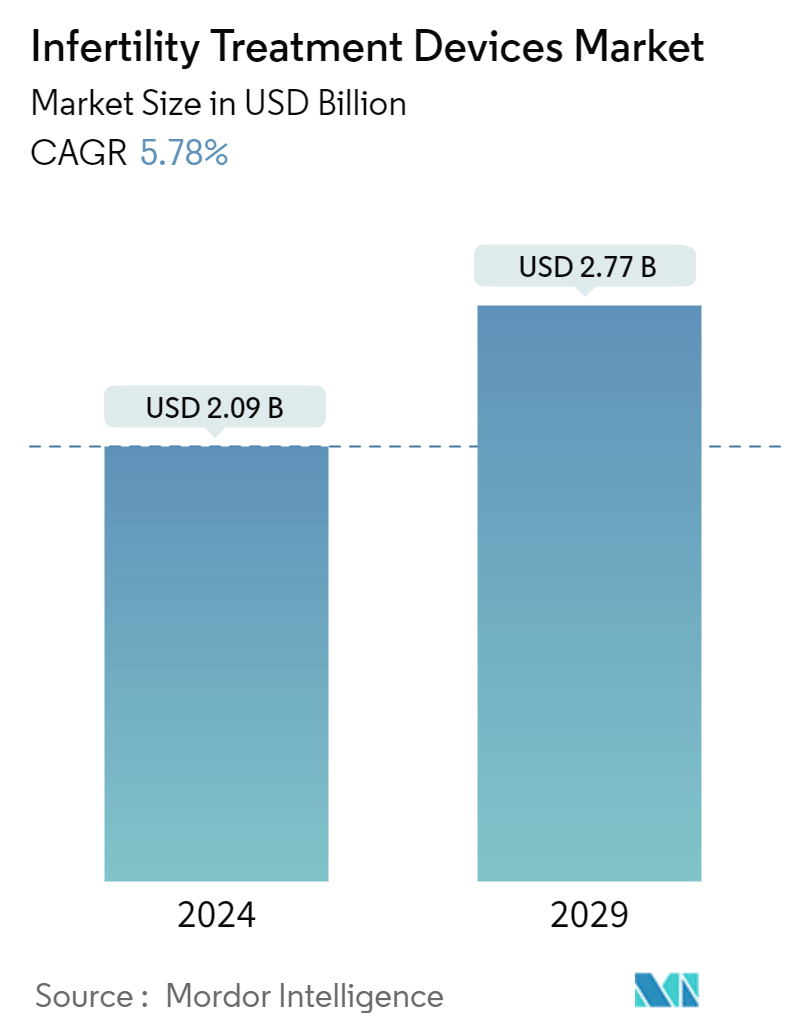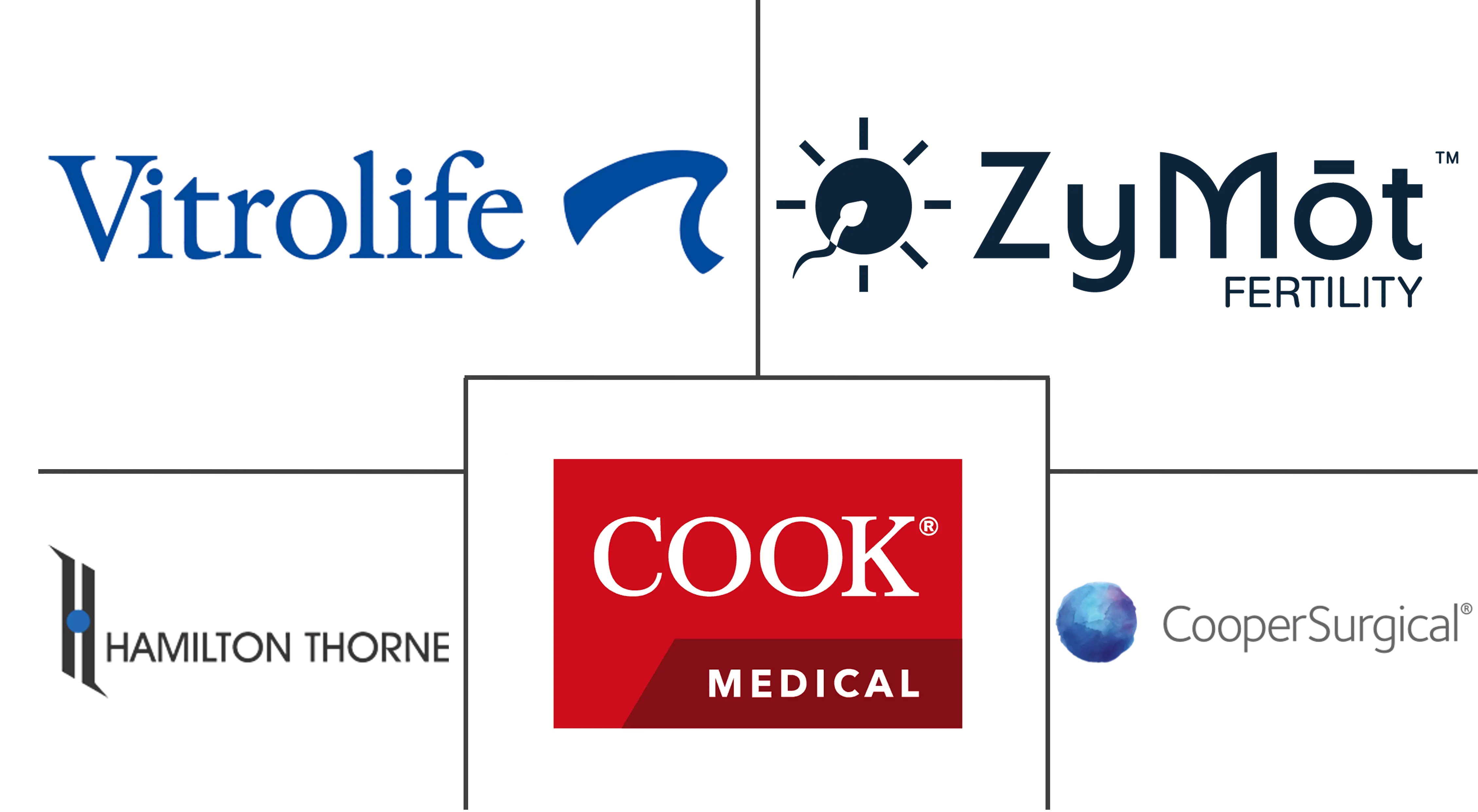Market Size of Infertility Treatment Devices Industry

| Study Period | 2019 - 2029 |
| Market Size (2024) | USD 2.09 Billion |
| Market Size (2029) | USD 2.77 Billion |
| CAGR (2024 - 2029) | 5.78 % |
| Fastest Growing Market | Asia Pacific |
| Largest Market | North America |
Major Players
*Disclaimer: Major Players sorted in no particular order |
Need a report that reflects how COVID-19 has impacted this market and its growth?
Infertility Treatment Devices Market Analysis
The Infertility Treatment Devices Market size is estimated at USD 2.09 billion in 2024, and is expected to reach USD 2.77 billion by 2029, growing at a CAGR of 5.78% during the forecast period (2024-2029).
COVID had a significant impact on the studied market. Various studies and articles have been published on the impact of COVID on in vitro fertilization (IVF). For instance, according to a research report published by PubMed Central in February 2021, SARS-CoV-2 is alleged to interfere with ART operations and disrupt female fertility via controlling ACE2. Consequently, it was anticipated that the pandemic would have an impact on market growth; however, with the decline in COVID-19 cases and widespread vaccination, it is anticipated that the studied market will once again reach its full potential over the forecast period.
The major factors attributing to the growth of the infertility treatment devices market are significant changes in lifestyle which contributed to the rise in infertility and the prevalence of conditions such as Polycystic Ovary Syndrome (PCOS). Also, a constant increase in the incidence of infertility in both sexes is projected to drive the market.
For instance, according to the data published by PubMed Central in June 2022, it was reported that South Korea showed the greatest decline in the fertility rate among the entire OECD countries over the last 30 years. The article also stated that the Korean government recognized the importance of healthy pregnancy and childbirth under these circumstances and implemented policies to raise the low fertility rate and support childbirth at advanced maternal by implementing 'The Fourth Basic Plan on Low Fertility and Aging Society' in 2021. Hence, a low fertility rate would increase the demand for in vitro fertilization and will increase market growth.
Furthermore, various development by market players and research institutes around the world are also contributing to the growth of the market. For instance, in March 2022, a few researchers from the Florida Atlantic University's College of Engineering and Computer Science developed a microfluidic chip-based device for sperm sorting that is fast, inexpensive, easy to operate, and efficiently isolates healthy sperm directly from semen. It effortlessly collects sorted sperm cells from the collecting chamber while minimizing contamination by deformed or dead sperm cells.
Thus, the abovementioned factors such as various development by market players and research institutes and low fertility rate are expected to increase market growth. However, the lack of availability to people due to the higher cost of IVF procedures and the possible risk of the baby being born with birth defects, risks of infections, and unfavorable scarring are expected to hinder the market growth.
Infertility Treatment Devices Industry Segmentation
As per the scope of the report, infertility treatment devices are used in assisted reproductive treatments (ARTs) such as IVFs, imaging systems, and other techniques employed in the several options for patient treatment depending on the causes of infertility. Healthcare facilities specializing in ART treatments require a license from the respective authorities present in the country. The Infertility Treatment Devices Market Is Segmented By Type (Sperm Separation Devices, Ovum Aspiration Pumps, Sperm Analyzer Systems, Micromanipulator Systems, Incubators, Cryosystems, Imaging Systems, Microscopes, and Others), End User (Fertility Clinics, Hospitals & Other Healthcare Facilities, and Clinical Research Institutes), and Geography (North America, Europe, Asia-Pacific, Middle East And Africa, and South America). The market report also covers the estimated market sizes and trends for 17 different countries across the major regions globally. The report offers the values (USD million) for the above segments.
| By Type | |
| Sperm Separation Devices | |
| Ovum Aspiration Pumps | |
| Sperm Analyzer Systems | |
| Micromanipulator Systems | |
| Incubators | |
| Cryosystems | |
| Imaging Systems | |
| Microscopes | |
| Others |
| By End-user | |
| Fertility Clinics | |
| Hospitals & Other Healthcare Facilities | |
| Clinical Research Institutes |
| Geography | ||||||||
| ||||||||
| ||||||||
| ||||||||
| ||||||||
|
Infertility Treatment Devices Market Size Summary
The infertility treatment devices market is expected to experience steady growth over the forecast period, driven by several key factors. Lifestyle changes have significantly contributed to the rising incidence of infertility, with conditions such as Polycystic Ovary Syndrome (PCOS) becoming more prevalent. The market is also benefiting from the increasing demand for in vitro fertilization (IVF) procedures, particularly in regions with declining fertility rates. Innovations in technology, such as the development of microfluidic chip-based devices for sperm sorting, are further propelling market expansion. Despite challenges such as the high cost of IVF procedures and potential health risks, the market is poised for growth, supported by advancements in medical technology and increasing awareness of reproductive health.
The North American region is anticipated to hold a significant share of the infertility treatment devices market, driven by a high infertility rate and a growing need for assisted reproductive technologies. Awareness programs and initiatives aimed at educating the public about infertility are also contributing to market growth in this region. The market is moderately competitive, with major players like CooperSurgical Inc, Hamilton Thorne Inc, and Cook Medical Inc leading the way. These companies are actively engaging in strategic partnerships and product launches to strengthen their market positions. Overall, the combination of technological advancements, increasing awareness, and a supportive regulatory environment is expected to drive the market's growth trajectory in the coming years.
Infertility Treatment Devices Market Size - Table of Contents
-
1. MARKET DYNAMICS
-
1.1 Market Overview
-
1.2 Market Drivers
-
1.2.1 Rise in Infertility and Prevalence of Conditions Such as Polycystic Ovary Syndrome (PCOS)
-
1.2.2 Increased Incidences of Infertility In Both Sexes
-
-
1.3 Market Restraints
-
1.3.1 Lack of Availability to People Due to Higher Cost of IVF Procedures
-
1.3.2 Possible Risk of Baby Being Born with Birth Defects, Risks of Infections and Unfavorable Scarring
-
-
1.4 Porter's Five Force Analysis
-
1.4.1 Threat of New Entrants
-
1.4.2 Bargaining Power of Buyers/Consumers
-
1.4.3 Bargaining Power of Suppliers
-
1.4.4 Threat of Substitute Products
-
1.4.5 Intensity of Competitive Rivalry
-
-
-
2. MARKET SEGMENTATION (Market Size by Value - USD million)
-
2.1 By Type
-
2.1.1 Sperm Separation Devices
-
2.1.2 Ovum Aspiration Pumps
-
2.1.3 Sperm Analyzer Systems
-
2.1.4 Micromanipulator Systems
-
2.1.5 Incubators
-
2.1.6 Cryosystems
-
2.1.7 Imaging Systems
-
2.1.8 Microscopes
-
2.1.9 Others
-
-
2.2 By End-user
-
2.2.1 Fertility Clinics
-
2.2.2 Hospitals & Other Healthcare Facilities
-
2.2.3 Clinical Research Institutes
-
-
2.3 Geography
-
2.3.1 North America
-
2.3.1.1 United States
-
2.3.1.2 Canada
-
2.3.1.3 Mexico
-
-
2.3.2 Europe
-
2.3.2.1 Germany
-
2.3.2.2 United Kingdom
-
2.3.2.3 France
-
2.3.2.4 Italy
-
2.3.2.5 Spain
-
2.3.2.6 Rest of Europe
-
-
2.3.3 Asia-Pacific
-
2.3.3.1 China
-
2.3.3.2 Japan
-
2.3.3.3 India
-
2.3.3.4 Australia
-
2.3.3.5 South Korea
-
2.3.3.6 Rest of Asia-Pacific
-
-
2.3.4 Middle East and Africa
-
2.3.4.1 GCC
-
2.3.4.2 South Africa
-
2.3.4.3 Rest of Middle East and Africa
-
-
2.3.5 South America
-
2.3.5.1 Brazil
-
2.3.5.2 Argentina
-
2.3.5.3 Rest of South America
-
-
-
Infertility Treatment Devices Market Size FAQs
How big is the Infertility Treatment Devices Market?
The Infertility Treatment Devices Market size is expected to reach USD 2.09 billion in 2024 and grow at a CAGR of 5.78% to reach USD 2.77 billion by 2029.
What is the current Infertility Treatment Devices Market size?
In 2024, the Infertility Treatment Devices Market size is expected to reach USD 2.09 billion.

